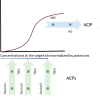Aggregate Exposure Pathways in Support of Risk Assessment
- PMID: 29736486
- PMCID: PMC5935252
- DOI: 10.1016/j.cotox.2018.03.006
Aggregate Exposure Pathways in Support of Risk Assessment
Abstract
Over time, risk assessment has shifted from establishing relationships between exposure to a single chemical and a resulting adverse health outcome, to evaluation of multiple chemicals and disease outcomes simultaneously. As a result, there is an increasing need to better understand the complex mechanisms that influence risk of chemical and non-chemical stressors, beginning at their source and ending at a biological endpoint relevant to human or ecosystem health risk assessment. Just as the Adverse Outcome Pathway (AOP) framework has emerged as a means of providing insight into mechanism-based toxicity, the exposure science community has seen the recent introduction of the Aggregate Exposure Pathway (AEP) framework. AEPs aid in making exposure data applicable to the FAIR (i.e., findable, accessible, interoperable, and reusable) principle, especially by (1) organizing continuous flow of disjointed exposure information;(2) identifying data gaps, to focus resources on acquiring the most relevant data; (3) optimizing use and repurposing of existing exposure data; and (4) facilitating interoperability among predictive models. Herein, we discuss integration of the AOP and AEP frameworks and how such integration can improve confidence in both traditional and cumulative risk assessment approaches.
Keywords: Adverse Outcome Pathway; Aggregate Exposure Pathway; risk assessment.
Conflict of interest statement
Conflicts of Interest The authors have no conflicts of interest to declare.
Figures


Similar articles
-
Organizing mechanism-related information on chemical interactions using a framework based on the aggregate exposure and adverse outcome pathways.Environ Int. 2020 May;138:105673. doi: 10.1016/j.envint.2020.105673. Epub 2020 Mar 24. Environ Int. 2020. PMID: 32217427 Free PMC article.
-
A Case Study Application of the Aggregate Exposure Pathway (AEP) and Adverse Outcome Pathway (AOP) Frameworks to Facilitate the Integration of Human Health and Ecological End Points for Cumulative Risk Assessment (CRA).Environ Sci Technol. 2018 Jan 16;52(2):839-849. doi: 10.1021/acs.est.7b04940. Epub 2017 Dec 29. Environ Sci Technol. 2018. PMID: 29236470 Free PMC article.
-
Application of a combined aggregate exposure pathway and adverse outcome pathway (AEP-AOP) approach to inform a cumulative risk assessment: A case study with phthalates.Toxicol In Vitro. 2020 Aug;66:104855. doi: 10.1016/j.tiv.2020.104855. Epub 2020 Apr 8. Toxicol In Vitro. 2020. PMID: 32278033 Free PMC article.
-
A Quantitative Source-to-Outcome Case Study To Demonstrate the Integration of Human Health and Ecological End Points Using the Aggregate Exposure Pathway and Adverse Outcome Pathway Frameworks.Environ Sci Technol. 2019 Sep 17;53(18):11002-11012. doi: 10.1021/acs.est.9b04639. Epub 2019 Sep 3. Environ Sci Technol. 2019. PMID: 31436975 Free PMC article.
-
Development and application of the adverse outcome pathway framework for understanding and predicting chronic toxicity: I. Challenges and research needs in ecotoxicology.Chemosphere. 2015 Feb;120:764-77. doi: 10.1016/j.chemosphere.2014.09.068. Epub 2014 Nov 11. Chemosphere. 2015. PMID: 25439131 Review.
Cited by
-
Organizing mechanism-related information on chemical interactions using a framework based on the aggregate exposure and adverse outcome pathways.Environ Int. 2020 May;138:105673. doi: 10.1016/j.envint.2020.105673. Epub 2020 Mar 24. Environ Int. 2020. PMID: 32217427 Free PMC article.
-
A proposal for creating a taxonomy of chemical interactions using concepts from the aggregate exposure and adverse outcome pathways.Curr Opin Toxicol. 2019 Aug 1;16:58-66. doi: 10.1016/j.cotox.2019.05.007. Curr Opin Toxicol. 2019. PMID: 33354636 Free PMC article.
-
Diesel Exhaust Extract Exposure Induces Neuronal Toxicity by Disrupting Autophagy.Toxicol Sci. 2020 Jul 1;176(1):193-202. doi: 10.1093/toxsci/kfaa055. Toxicol Sci. 2020. PMID: 32298450 Free PMC article.
-
Quantification of an Adverse Outcome Pathway Network by Bayesian Regression and Bayesian Network Modeling.Integr Environ Assess Manag. 2021 Jan;17(1):147-164. doi: 10.1002/ieam.4348. Epub 2020 Oct 23. Integr Environ Assess Manag. 2021. PMID: 32965776 Free PMC article.
-
Adopting Mechanistic Molecular Biology Approaches in Exposome Research for Causal Understanding.Environ Sci Technol. 2024 Apr 30;58(17):7256-7269. doi: 10.1021/acs.est.3c07961. Epub 2024 Apr 19. Environ Sci Technol. 2024. PMID: 38641325 Free PMC article. Review.
References
-
- NRC. Using 21st Century Science to Improve Risk-Related Evaluations. National Academies Press (US); 2017. https://www.ncbi.nlm.nih.gov/books/NBK424987/ accessed April 4, 2017. - PubMed
-
- Meek ME(Bette), Palermo CM, Bachman AN, North CM, Lewis R Jeffrey. Mode of action human relevance (species concordance) framework: Evolution of the Bradford Hill considerations and comparative analysis of weight of evidence. J Appl Toxicol. 2014;34:595–606. doi: 10.1002/jat.2984. - DOI - PMC - PubMed
-
- Ankley GT, Bennett RS, Erickson RJ, Hoff DJ, Hornung MW, Johnson RD, Mount DR, Nichols JW, Russom CL, Schmieder PK, Serrrano JA, Tietge JE, Villeneuve DL. Adverse outcome pathways: a conceptual framework to support ecotoxicology research and risk assessment. Environ Toxicol Chem. 2010;29:730–741. doi: 10.1002/etc.34. - DOI - PubMed
-
- Villeneuve DL, Crump D, Garcia-Reyero N, Hecker M, Hutchinson TH, LaLone CA, Landesmann B, Lettieri T, Munn S, Nepelska M, Ottinger MA, Vergauwen L, Whelan M. Adverse outcome pathway (AOP) development I: strategies and principles. Toxicol Sci. 2014;142:312–320. doi: 10.1093/toxsci/kfu199. - DOI - PMC - PubMed
Grants and funding
LinkOut - more resources
Full Text Sources
Other Literature Sources
Research Materials
